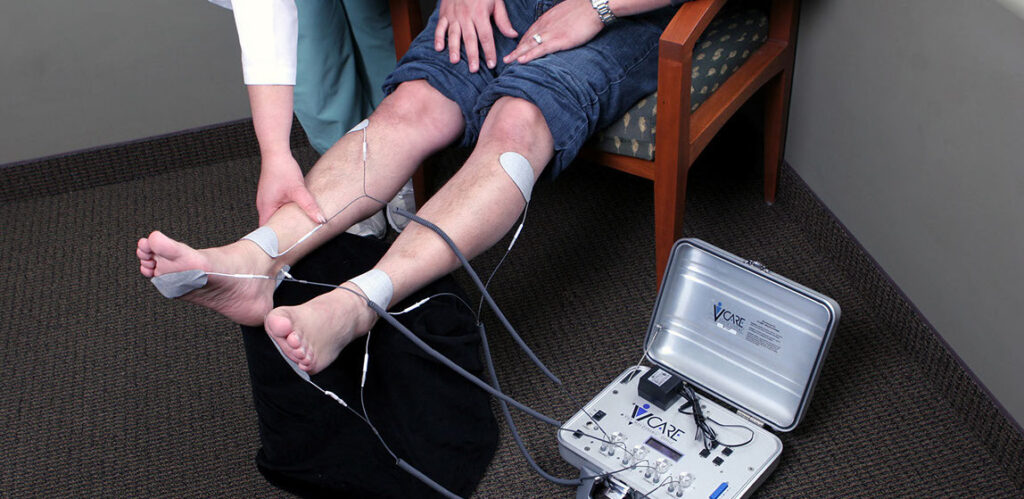Peripheral Neuropathy refers to the conditions that result when nerves that carry messages to and from the brain and spinal cord from and to the rest of the body are damaged or diseased. The peripheral nerves make up an intricate network that connects the brain and spinal cord to the muscles, skin, and internal organs. Peripheral nerves come out of the spinal cord and are arranged along lines in the body called dermatome. Typically, damage to a nerve will affect one or more dermatome, which can be tracked to specific areas of the body. Damage to these nerves interrupts communication between the brain and other parts of the body and can impair muscle movement, prevent normal sensation in the arms and legs, and cause pain.
Types of Peripheral Neuropathy
There are several different kinds of peripheral neuropathies that stem from a variety of causes. They range from carpal tunnel syndrome (a traumatic injury common after chronic repetitive use of the hands and wrists, such as with computer use) to nerve damage linked to diabetes.
As a group, peripheral neuropathies are common, especially among people over the age of 55. Altogether, the conditions affect 3% to 4% of people in this group.
Neuropathies are typically classified according to the problems they cause or what is at the root of the damage. There also are terms that express how extensively the nerves have been damaged.
Mononeuropathy
Damage to a single peripheral nerve is called Mononeuropathy. Physical injury or trauma such as from an accident is the most common cause. Prolonged pressure on a nerve, caused by extended periods of being sedentary (such as sitting in a wheelchair or lying in bed), or continuous, repetitive motions, can trigger a mononeuropathy.
Carpal tunnel syndrome is a common type of Mononeuropathy. It is called an overuse strain injury, which occurs when the nerve that travels through the wrist is compressed. People whose work requires repeated motions with the wrist (such as assembly-line workers, physical laborers, and those who use computer keyboards for prolonged periods) are at greater risk.
Polyneuropathy
Polyneuropathy accounts for the greatest number of peripheral neuropathy cases. It occurs when multiple peripheral nerves throughout the body malfunction at the same time. Polyneuropathy can have a wide variety of causes, including exposure to certain toxins such as with alcohol abuse, poor nutrition (particularly vitamin B deficiency), and complications from diseases such as cancer or kidney failure.
One of the most common forms of chronic s diabetic neuropathy, a condition that occurs in people with diabetes. It is more severe in people with poorly controlled blood sugar levels. Though less common, diabetes can also cause a mononeuropathy.
The most common symptoms of Polyneuropathy are:
- Tingling
- Numbness
- Loss of sensation in the arms and legs
- A burning sensation in the feet or hands

What Causes Peripheral Neuropathy?
There are many factors that can cause Peripheral Neuropathies, so it is often difficult to pinpoint the origin. Neuropathies occur by one of three methods:
- Acquired Neuropathies are caused by environmental factors such as toxins, trauma, illness, or infection. Known causes of acquired neuropathies include:
- Diabetes.
- Several rare inherited diseases.
- Alcoholism.Poor nutrition or vitamin deficiency.
- Certain kinds of cancer and chemotherapy used to treat them.
- Conditions where nerves are mistakenly attacked by the body’s own immune system or damaged by an overaggressive response to injury.
- Certain medications.Kidney or thyroid disease.
- Infections such as Lyme disease, shingles, or AIDS
Hereditary Neuropathies are not as common. Hereditary Neuropathies are diseases of the peripheral nerves that are genetically passed from parent to child.
The most common of these is Charcot-Marie-Tooth disease type
1. It is characterized by weakness in the legs and, to a lesser degree, the arms — symptoms that usually appear between mid-childhood and age 30. This disease is caused by degeneration of the insulation that normally surrounds the nerves and helps them conduct the electrical impulses needed for them to trigger muscle movement.
Idiopathic neuropathies are from an unknown cause. As many as one-third of all Neuropathies are classified in this way.


